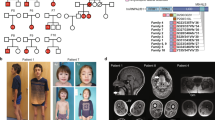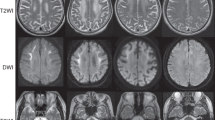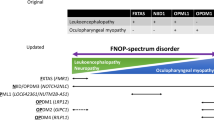Abstract
Autosomal dominant oculopharyngeal muscular dystrophy (OPMD) is an adult-onset disease with a world-wide distribution1. It usually presents in the sixth decade with progressive swallowing difficulties (dysphagia), eyelid drooping (ptosis) and proximal limb weakness. Unique nuclear filament inclusions in skeletal muscle fibres are its pathological hallmark2. We isolated the poly(A) binding protein 2 gene (PABP2) from a 217-kb candidate interval on chromosome 14q11 (B.B. et al., manuscript submitted). A (GCG)6 repeat encoding a polyalanine tract located at the N terminus of the protein was expanded to (GCG)8–13 in the 144 OPMD families screened. More severe phenotypes were observed in compound heterozygotes for the (GCG)9 mutation and a (GCG)7 allele that is found in 2% of the population, whereas homozygosity for the (GCG)7 allele leads to autosomal recessive OPMD. Thvs the (GCG)7 allele is an example of a polymorphism which can act either as a modifier of a dominant phe-notype or as a recessive mutation. Pathological expansions of the polyalanine tract may cause mutated PABP2 oligomers to accumulate as filament inclusions in nuclei.
This is a preview of subscription content, access via your institution
Access options
Subscribe to this journal
Receive 12 print issues and online access
$209.00 per year
only $17.42 per issue
Buy this article
- Purchase on Springer Link
- Instant access to full article PDF
Prices may be subject to local taxes which are calculated during checkout
Similar content being viewed by others
References
Tomé, F.M.S. & Fardeau, M. in Myology (eds Engel, A.G. & Franzini-Armstrong, C.) 1233–1245 (McGraw-Hill, New York, 1994).
Tomé, F.M.S. & Fardeau, M. Nuclear inclusions in oculopharyngeal muscular dystrophy. Acta Neuropath. 49, 85–87 (1980).
Rommens, J.M., Mar, L., McArthur, J., Tsui, L.-C. & Scherer, S. in Proceedings of the Third International Workshop on the Identification of Transcribed Sequences (eds Hochgeschwender, U. & Gardiner, K.) 65–79 (Plenum, New York, 1994).
Nemeth, A. et al. Isolation of genomic and cDNA clones encoding bovine poly(A) binding protein II. Nucleic Acids Res. 23, 4034–4041 (1995).
Krause, S., Fakan, S., Weis, K. & Wahle, E. Immunodetection of poly(A) binding protein II in cell nucleus.Exp. Cell Res. 214, 75–82 (1994).
Wahle, E. A novel poly(A)-binding protein acts as a specificity factor in the second phase of messenger RNA polyadenylation. Cell 66, 759–768 (1991).
Wahle, E., Lustig, A., Jenö, P. & Maurer, P., Poly(A)-binding protein II. J. Biol. Chem. 268, 2937–2945 (1993).
Bienroth, S., Keller, W. & Wahle, E. Assembly of a processive messenger RNA polyadenylation complex. EMBO J. 12, 585–594 (1993).
Brais, B. et al The oculopharyngeal muscular dystrophy locus maps to the region of the cardiac a and |3 myosin heavy chain genes on chromosome 14q11.2-q13. Hum. Mol. Genet. 4, 429–434 (1995).
Rosenberg, R.N. DNA-triplet repeats and neurologic disease. New Eng. J. Med. 335, 1222–1224 (1996).
Bouchard, J.-P., Marcoux, S., Gosselin, F., Pineault, D. & Rouleau, G.A. A simple test for the detection of the dysphagia in members of families with oculophayngeal muscular dystrophy (OPMD). Can. J. Neurol. Sci. 19, 296–297 (1992).
Richards, R.I. & Sutherland, G.R. Dynamic mutations: a new class of mutations causing human disease. Cell 70, 709–712 (1992).
Muragaki, Y., Mundlos, S., Upton, J. & Olsen, B.R. Altered growth and branching patterns in synpolydactyly caused by mutations in HOXD13. Science 272, 548–551 (1996).
Akarsu, A.N., Stoilov, I., Yilmaz, E., Sayli, B.S. & Sarfarazi, M. Genomic structure of HOXD13 gene: a nine polyalanine duplication causes synpolydactyly in two unrelated families. Hum. Mol. Genet. 5, 945–952 (1996).
Mundlos, S. et al Mutations involving the transcription factor CBFA1 cause cleidocranial dysplasia. Cell 89, 773–779 (1997).
Green, H. Human genetic diseases due to codon reiteration: relationship to an evolutionary mechanism. Cell 24, 955–956 (1993).
Warren, S.T. Polyalanine expansion in synpolydactyly might result from unequal crossing-over of HOXD13. Science 275, 408–409 (1997).
Wells, D.R. Molecular basis of genetic instability of triplet repeats. J. Biol. Chem. 271, 2875–2878 (1996).
Davies, S.W. et al. Formation of neuronal intranuclear inclusions underlies the neurological dysfunctions in mice transgenic for the HD mutation. Cell 90, 537–548 (1997).
Riggins, G.J. et al Human genes containing polymorphic trinucleotide repeats. Nature Genet. 2, 186–191 (1992).
Simmons, A.H., Michal, C.A. & Jelinski, L.W. Molecular orientation and two-component nature of the crystalline fraction of spider dragline silk. Science 271, 84–87 (1996).
Forood, B., Pérez-Payá, E., Houghten, R.A. & Blondelle, S.E. Formation of an extremely stable polyalanine B-sheet macromolecule. Bioch. Biophys. Res. Comm. 211, 7–13 (1995).
DiFiglia, M. et al Aggregation of Huntingtin in neuronal intranuclear inclusions and dystrophic neurites in brain. Science 277, 1990–1993 (1997).
Paulson, H.L. et al Intranuclear inclusions of expanded polyglutamine protein in spinocerebellar ataxia type 3. Neuron 19, 333–344 (1997).
Scherzinger, E. et al Huntingtin-encoded polyglutamine expansions form amyloid-like protein aggregates in vitro and in vivo. Cell 90, 549–558 (1997).
Skinner, P.J. et al. Ataxin-1 with an expanded glutamine tract alters nuclear matrix-associated structures. Nature 389, 971–974 (1997).
Evans, G.A., Lewis, K. & Rothenberg, B.E. High efficiency vectors for cosmid microcloning and genomic analysis. Gene 79, 9–20 (1989).
Lafrenière, R.G. et al 5′ flanking region of the cystatin B gene is the most common mutation in progressive myoclonus epilepsy type 1, EPM1. Nature Genet. 15, 298–302 (1997).
Brunet, G., Tomé, F.M.S., Samson, F., Robert, J.M. & Fardeau, M. Dystrophie musculaire oculo-pharyngée. Recensement des families franchises éet tude généalogique. Rev. Neurol. 146, 425–429 (1990).
Blumen, S.C. et al Clinical features of oculopharyngeal muscular dystrophy among Bukhara Jews. Neuromusc. Disord. 3, 575–577 (1993).
Author information
Authors and Affiliations
Corresponding author
Rights and permissions
About this article
Cite this article
Brais, B., Bouchard, JP., Xie, YG. et al. Short GCG expansions in the PABP2 gene cause oculopharyngeal muscular dystrophy. Nat Genet 18, 164–167 (1998). https://doi.org/10.1038/ng0298-164
Received:
Accepted:
Issue Date:
DOI: https://doi.org/10.1038/ng0298-164
This article is cited by
-
PABPN1 regulates mRNA alternative polyadenylation to inhibit bladder cancer progression
Cell & Bioscience (2023)
-
Resequencing of the TMF-1 (TATA Element Modulatory Factor) regulated protein (TRNP1) gene in domestic and wild canids
Canine Medicine and Genetics (2023)
-
Characteristics of the muscle involvement along the disease progression in a large cohort of oculopharyngodistal myopathy compared to oculopharyngeal muscular dystrophy
Journal of Neurology (2023)
-
Intranuclear inclusions in muscle biopsy can differentiate oculopharyngodistal myopathy and oculopharyngeal muscular dystrophy
Acta Neuropathologica Communications (2022)
-
Transillumination Assisted Cricopharyngeal Myotomy
Indian Journal of Otolaryngology and Head & Neck Surgery (2022)



